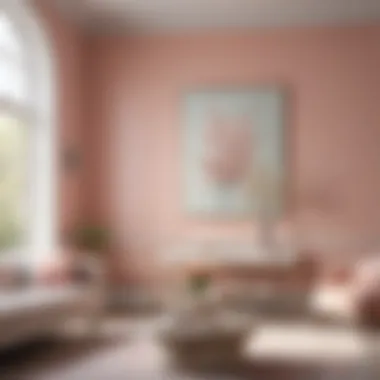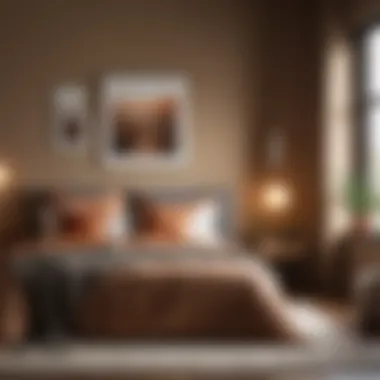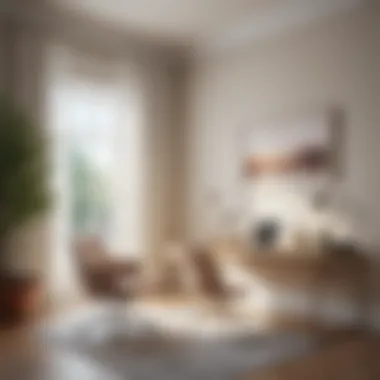Optimal Paint Colors for Naturally Lit Rooms


Intro
Selecting the optimal paint colors for rooms that receive abundant natural light is not just a matter of aesthetics; it involves a deeper understanding of how light interacts with color. Natural light can transform hues, altering their perception and intensity throughout the day. This phenomenon can be both an advantage and a challenge. Therefore, it becomes essential to carefully curate a palette that enhances the room’s characteristic while maintaining a sophisticated ambiance.
This article aims to provide insightful guidance for luxury homeowners and designers navigating this unique aspect of interior design. By exploring how light affects color perception, we will present color palettes tailored for various room types, alongside important factors to consider in your selection process. Ultimately, the goal is to equip you with the knowledge and tools needed to make informed, stylish decisions for your sunlit spaces.
Outdoor Decor Ideas
Outdoor decor extends the elegance of indoor spaces into the sunlit exteriors. When designing these areas, it is critical to select colors that resonate with both the environment and the purpose of the space.
Seasonal Inspirations
Incorporating seasonal colors can breathe new life into outdoor settings. For instance, spring calls for lively shades of green and bright floral tones that reflect the freshness of the season. Summer is ideal for soft pastels, while the autumn palette can embrace warm earth tones. Winter is often best with deep jewel tones that exude warmth, even in the cooler months.
Furniture Selection
Choosing the right furniture complements the paint colors and allows for a cohesive design. For bright sunlit areas, consider materials that can withstand UV exposure, such as teak or powder-coated aluminum. Selecting colors like crisp whites and subdued grays for the furniture can enhance the vibrancy of walls painted in brighter shades while providing a modern contrast.
Decorative Lighting
In well-lit outdoor spaces, lighting choices can dramatically affect the atmosphere. Fixtures in gold or brass can create an element of luxury, while minimalist designs in matte black add a modern touch. Lighting should enhance the color palette without overpowering it. Soft, warm lights are preferable to encourage a relaxing environment.
Plant Arrangements
Plants introduce a refreshing natural element to outdoor decor. Greenery can also create harmonious contrasts against painted surfaces. Selecting a variety of plant sizes and colors allows for visual interest. Consider using terracotta pots in neutral hues to maintain focus on the vibrant greenery.
Hardscaping Solutions
The choices in hardscaping materials also impact your palett. Opt for neutral stones or concrete bases to provide a stable background that can support more colorful decor elements. Use darker stones to contrast vividly painted walls, creating a striking visual dynamic.
Sustainable Practices
Incorporating sustainable practices in your outdoor decor not only elevates the aesthetic but also enhances the emotional connection to the space. Consider using low-VOC paints and sustainable materials in your selections. Emphasizing organic forms and locally sourced items can also contribute to a thoughtful design.
"Color has a significat effect on ambiance. When natural light plays over colors, the interplay creates a unique environment that can feel both inviting and sophisticated."
In summary, outdoor decor is about creating a seamless transition between indoor and outdoor spaces. By thoughtfully selecting paint colors and accessories, you can enhance the overall harmony and beauty in environments drenched in natural light.
Understanding Light and Color
Choosing paint colors for a room where natural light predominates requires understanding how light influences color perception. This knowledge not only enhances aesthetic appeal but also affects the atmosphere of a space. Properly selecting paint colors based on the behavior of light can create a harmonious and inviting environment.
The Interaction of Light and Paint
Light acts as a mediator between the paint and the observer. As natural light changes throughout the day, colors in a room can appear drastically different. Factors such as sunlight intensity, angle, and even weather conditions can alter our perception of colors on walls. When contemplating a color scheme, it is essential to conduct tests at various times. This ensures that the paint's appearance aligns with your intentions without unexpected surprises.
Color Temperature and Its Impact
Color temperature divides tones into two categories: warm and cool. Warm colors like reds, oranges, and yellows often create a sense of coziness; while cool colors like blues, greens, and purples can evoke calmness and spaciousness. In brightly lit rooms, warm colors may become overly intense and can make the space feel uncomfortably hot. In contrast, cool colors can provide a refreshing ambiance. It is vital to determine the dominant color temperature of a room to select complementary or contrasting tones that feel balanced and pleasant.
The Role of Natural vs. Artificial Light
Natural light varies significantly from artificial light. While natural sunlight is full spectrum and can highlight the vibrancy of colors, artificial sources usually have a limited spectrum and temperature variance. For instance, incandescent bulbs can skew colors warmer, while fluorescent lights can make them appear cooler. This contrast affects how paint colors are perceived. Understanding this distinction allows for better choice in color selection that compliments, rather than competes with, natural light. A successful design will seamlessly integrate paint colors with the room’s operating light sources to achieve an impactful and cohesive look.
"Proper understanding of light in relation to color selection can elevate the design of any living space and enhance the overall mood."
Factors Influencing Color Choice


Choosing the right paint color significantly affects the overall ambiance of a room, especially in spaces flooded with natural light. It is crucial to consider various factors that influence this decision, as they help create a harmonious environment.
Specific Elements
One of the primary elements to consider is the functionality of the room. The intended use shapes the desired mood. A tranquil bedroom may benefit from soothing tones, while a vibrant kitchen can embrace lively colors. Aligning color choices with the purpose of the space maximizes comfort and satisfaction for its inhabitants.
Another element is the size and scale of the room. Light colors can make smaller spaces feel more expansive, while darker shades can create a sense of coziness. Thus, evaluating the physical dimensions influences the selection process significantly.
Benefits of Consideration
In terms of benefits, acknowledging these factors can lead to a more tailored and pleasing environment. Thoughtful color choices not only reflect personal style but also enhance the functionality of each space.
Considerations about Factors Influencing Color Choice
One must also consider existing decor and furnishings. A well-coordinated palette can unify the overall aesthetic and avoid clashing elements. This critical aspect ensures that new colors complement rather than overwhelm the existing design.
Prioritizing these factors can help avoid common pitfalls in color selection. Misaligned colors can adversely affect the room's usability and the owner's experience. As one navigates the intricate process of picking the right hues, a focus on these guiding elements offers a clear pathway toward creating well-balanced environments.
Color Palettes for Natural Light
The selection of paint colors for rooms that receive a generous amount of natural light is a significant factor that can influence the aesthetics and mood of a space. Natural light varies throughout the day, interacting with colors in unique ways. Understanding this interaction is essential in making informed choices.
By selecting the right color palette, one can enhance the finer details of a room, ensuring that the interplay of light and color works harmoniously. This process not only fulfills aesthetic goals but also impacts the ambiance and function of the space. Therefore, exploring various color palettes can provide invaluable insights into how best to utilize the light within any given room.
Neutrals: Timeless and Versatile
Warm Whites
Warm whites are often appreciated for their ability to create a cozy and inviting atmosphere. This choice promotes a bright and airy feel while maintaining a certain warmth that invites comfort. They effectively reflect natural light, which helps to keep spaces feeling open and spacious.
A notable feature of warm whites is their versatility. They pair well with a variety of decor styles, making them an enduring option for many homeowners. However, it is worth considering that in areas where there is less natural light, warm whites may appear dull or lackluster.
Cool Grays
Cool grays bring an air of sophistication and modernity to a space. They are particularly effective in creating a calm and serene atmosphere. The unique characteristic of cool grays is their ability to adapt based on the light they receive, appearing lighter in sunny settings while taking on deeper tones in shadow.
This color choice is popular because it works well with both minimalistic and traditional designs. On the downside, it can make a room feel colder or more sterile if not balanced with warm elements in the decor.
Soft Beiges
Soft beiges strike a careful balance between warmth and neutrality. This color is known for its ability to evoke a feeling of tranquility. Soft beiges blend seamlessly with a variety of materials and finishes, enhancing the richness of a room.
One unique feature of soft beiges is their subtle adaptability. They can shift in tone depending on the light conditions, providing warmth in the sun and a gentle softness in overcast moments. Yet, they may sometimes be perceived as lacking in personality, an aspect that should be considered when aiming for a distinct style.
Pastels: Subtle Touches of Color
Pale Blues
Pale blues are often associated with tranquility and peace. In rooms flooded with natural light, they enhance the sense of openness, evoking a serene atmosphere. The key characteristic of pale blues is their ability to reflect the natural surroundings, which can enhance the overall decor effectively.
This shade is beneficial for creating a calming environment, making it a popular choice for bedrooms and relaxation areas. However, the disadvantage might include a tendency to appear washed out in poorly lit conditions.
Mint Greens
Mint greens introduce a refreshing quality to rooms. This color has a crispness that can rejuvenate any space, making it ideal for kitchens and areas meant for socializing. The unique aspect of mint greens is their cheerful vibrancy without being overpowering.
They enhance the uplifting qualities of natural light, contributing to an inviting atmosphere. Nevertheless, an excess of mint greene can sometimes clash with certain wooden tones or darker furniture, leading to visual confusion.
Soft Lavenders
Soft lavenders are rarely used but offer a gentle and sophisticated feel. This shade tends to harmonize with both modern and traditional decor. The soothing nature of lavender can create a relaxing environment, echoing the tranquility of a sunlit room.
However, one must be cautious with soft lavenders. In rooms with excessive sunlight, they can fade quickly. Thus, maintaining their vibrancy is crucial for ensuring the desired impact over time.


Bold Colors: Creating Impact
Deep Blues
Deep blues convey strength and elegance. In naturally lit spaces, they provide a striking contrast while maintaining a sense of depth. The richness of deep blues enhances the aesthetic appeal, creating a dramatic focal point in a room.
They work well in both contemporary and classic styles, making them a versatile option. However, they can overwhelm smaller spaces when not balanced with lighter accents or finishes.
Rich Greens
Rich greens evoke a connection to nature, creating a soothing environment. This color reflects elements of the outdoors, promoting a refreshing ambiance. It is a popular choice for rooms intended for relaxation, such as living rooms.
The unique feature of rich greens is their timelessness. However, caution is warranted as darker greens can make a room feel smaller if used excessively.
Terracotta Tones
Terracotta tones bring warmth and earthiness to a space. Their natural undertones create a welcoming environment that can brighten a room bathed in sunlight. They are popular for creating a rustic feel and work well in kitchens and dining areas.
However, terracotta tones can clash with cooler color palettes, leading to a lack of harmony in the overall design. Thus, careful consideration of the surrounding colors is essential when opting for this choice.
Determining the Right Finish
Selecting the right finish for paint can profoundly influence the overall aesthetic and functionality of a room, especially those with ample natural light. Each finish contributes differently to how colors appear and how light interacts with those colors. Understanding the nuances of finishes is essential for achieving a harmonious environment, manipulating light reflections, and enhancing or subduing colors.
When it comes to rooms bathed in natural light, the finish not only serves aesthetic purposes but also practical ones. Certain finishes reflect light more significantly, which can amplify or alter the perceived brightness and warmth of a color. This is particularly important in spaces where light changes throughout the day. By carefully considering the right finish, one can maximize the impact of the chosen color palette while also meeting the functional needs of the space.
Matte Finishes: Subdued Elegance
Matte finishes offer a soft, non-reflective quality that can create a calm and elegant atmosphere. They work exceptionally well in spaces where you want to emphasize a certain color while downplaying glare from natural light. In living rooms or bedrooms with large windows, a matte finish can contribute to a cozy ambience while allowing other decor elements to shine.
However, it is crucial to note that matte finishes can be less durable and practical in high-traffic areas or spaces with high humidity, such as kitchens or bathrooms. Considerations around maintenance should guide your choice if you lean towards this sophisticated finish.
Eggshell Finishes: A Balance of Sheen and Softness
Eggshell finishes bridge the gap between matte and satin. They provide a slight sheen, allowing light to reflect beautifully without overwhelming the room. This finish works best for areas that require some durability, such as hallways or children’s rooms, where you may need a finish that can withstand minor scuffs. The slight reflective quality also adds depth to light colors, making them appear more vibrant when sunlight hits the walls.
Eggshell finishes are versatile and can complement a variety of color palettes, especially softer hues. This means that even in naturally bright rooms, you can maintain a sense of softness while achieving visual interest.
Satin and Gloss Finishes: Reflecting Light
Satin and gloss finishes are highly reflective, maximizing the impact of natural light. These finishes enhance colors' brightness, making them ideal for rooms that might otherwise feel dull. Kitchens, bathrooms, and playrooms benefit from this finish because they are more resistant to moisture and easier to clean.
However, excessive gloss can create an overwhelming glare in rooms flooded with natural light. Thus, strategic use of these finishes in specific areas can balance aesthetics with practicality. For instance, consider using a satin finish on cabinetry while opting for a matte or eggshell finish on the walls to create contrast and interest.
Conclusion: The right finish is essential for both aesthetics and functionality. When choosing a finish in rooms with natural light, balance sheen with color to achieve the desired results. Evaluate each area based on its use and light exposure, allowing for informed decisions that enhance the overall space.
Tips for Application and Coordination
Choosing paint colors for rooms that receive a lot of natural light requires careful consideration. It is not just about the colors themselves; application and coordination play a crucial role in achieving the desired aesthetic. The way colors interact with each other and how they look in different lighting can significantly impact the final appearance of a space.
Testing Colors in Different Lighting
Understanding that light changes throughout the day is essential. Natural light varies in intensity and color temperature at different times. A color that appears warm in the morning may look cooler by evening. Therefore, testing colors under the actual lighting conditions of the room is key.
- Take Samples: Acquire small samples of your chosen paints. Most stores offer sample sizes.
- Paint Swatches: Apply these samples on the walls at different locations. Use multiple coats if needed to see the true depth of the color.
- Observe Changes: Check the colors at different times of day—morning, afternoon, and evening. This helps to understand how the light affects your color choices.
By doing so, you ensure that the final color works harmoniously with the natural light present in your room.


Creating Cohesion Between Rooms
When painting multiple spaces, maintaining a sense of cohesion is crucial. A home should feel connected, with colors that flow from one room to another.
- Color Palette: Choose a unified color palette that can extend through interconnected spaces. This does not mean every room should be the same color, but they should complement each other.
- Transitions: Think about how light influences transitions between rooms. If one space is predominantly lit by morning sun while another gets evening light, select colors that will appear consistent throughout the day.
- Accent Colors: Use accent colors to link rooms. For instance, a shared accent can appear in artwork or accessories, tying rooms together without being overly matchy.
Utilizing Color Samples Effectively
Effectively utilizing color samples allows for informed decision-making. A good approach involves looking beyond mere color perception.
- Room Context: Consider how the colors look against the room’s architecture, flooring, and furnishings. Samples should be evaluated within the context they will exist.
- Before Full Application: Do not rush into painting entire walls. Use samples to create a mood board first. It allows for visualization of how various colors work together before making a commitment.
- Collaboration: Consult with professionals like interior designers if needed. Their expertise can bring valuable insight, particularly in coordinating intricate palettes across various spaces.
"The right color can considerably change a space. It can enhance the natural beauty of light while reflecting personal style."
By following these practical tips on application and coordination, you can significantly elevate the aesthetics of well-lit rooms. Careful planning and thoughtful execution lead to a harmonious and inviting environment.
Common Mistakes to Avoid
Understanding common mistakes in selecting paint colors for rooms with abundant natural light is crucial for achieving the desired aesthetic effect. Awareness of these pitfalls can save both time and resources, allowing for more deliberate and effective design choices.
Choosing Colors Based on Trends Alone
One prevalent error is choosing colors purely based on current trends. While trends can provide inspiration, they may not always align with individual tastes or the room's specific characteristics. Trends often emphasize bold or unusual colors which, although visually appealing at times, can lose their charm quickly.
It's important to consider how a color interacts with the natural light in the space. A trending hue might look stunning in a magazine but may create an uncomfortable atmosphere in a specific room. Thus, selecting colors should involve careful consideration of the unique setting rather than relying solely on what is fashionable.
Benefits of Authentic Choices:
- Personal Expression: Selecting colors that resonate personally ensures a more authentic and satisfying living environment.
- Longevity of Appeal: A timeless color palette will maintain its attractiveness as trends fade.
- Enhanced Comfort: A thoughtful choice leads to greater comfort, crucial for the ambiance of the room.
Ignoring the Effects of Light Throughout the Day
Another common mistake is neglecting how daylight changes the perception of color throughout the day. Natural light varies in intensity and color temperature based on the time of day. Morning light is often warmer, while afternoon light is brighter and cooler. Therefore, a color observed in one part of the day might appear wholly different later.
Testing paint colors at various times can provide insights into how they will react with changing light conditions. Taking this into account can help ensure that the selected colors remain flattering and cohesive as the sunlight shifts.
Key Considerations:
- Time of Day: Observe colors from morning through evening.
- Seasonal Changes: Consider how different seasons might affect light quality and warmth.
Disregarding Harmony with Other Elements
Finally, a mistake often made is overlooking the harmony between paint colors and other elements in the room, such as furniture, flooring, and accessories. A successful design is one where all components resonate clearly with one another. Choosing a color without considering existing furnishings can create a jarring contrast that disrupts the overall flow of the space.
Strategies for Avoiding Disruption:
- Sample Swatches: Use swatches to visualize how paint colors will interact with furniture and decor before making a decision.
- Cohesive Color Schemes: Consider colors that complement or contrast in a refined and visually pleasant manner.
Finale
Understanding how colors interact with natural light allows homeowners and designers to create spaces that are not only visually appealing but also functional. When light plays on paint, the hues can change throughout the day, offering a dynamic atmosphere. This variation encourages a deeper appreciation for the interplay between light and color in designing interiors.
Reflecting Personal Style Through Color
Selecting paint colors gives an opportunity to articulate one’s personal style. Each color carries unique meanings and emotions, and the right choice can express individual taste. For instance, a bold teal may convey confidence, while a soft cream reflects tranquility. This element of personal expression is paramount in a world where individualism is celebrated.
Furthermore, choosing paint colors is often about balancing personal preference with practical considerations. One must consider how colors work in a specific room versus the overall decor scheme of the home. A cohesive approach enables not only visual impact but also a sense of harmony within the spaces. When rooms reflect one’s personality, they become more inviting and enjoyable.
The Lasting Impact of Thoughtful Choices
Thoughtful choices in color selection extend beyond the immediate visual effects. They can influence how spaces are perceived over time. Well-selected colors can enhance natural light, making rooms appear more spacious and inviting. These effects contribute to a homeowner’s comfort and satisfaction with their environment.
Moreover, colors can also affect the resale value of a home. Homes with harmoniously chosen palettes that appeal to a broad audience tend to perform better in the real estate market. It is advisable to favor timeless color schemes that transcend trends, ensuring lasting appeal.
In summary, the conclusions drawn in this article highlight the strategic essence of color choice as a sophisticated and nuanced aspect of interior design. By understanding and applying the principles discussed, individuals can create not only beautiful spaces but also personalized sanctuaries that encapsulate their unique styles and enhance their quality of life.







